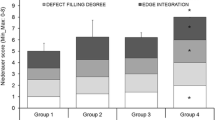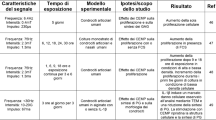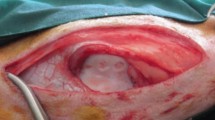Abstract
This study aimed to determine the efficacy of PEMF (pulsed electromagnetic field) treatment in experimental osteochondral defect healing in a rabbit model. The study was conducted on 12 New Zealand white rabbits. Six rabbits formed the study group and six rabbits the control group. The right knee joints of all 12 animals were exposed and a 3.5-mm diameter osteochondral defect was created in the trochlear groove. The defect was filled with calcium phosphate scaffold. Six animals from the study group were given PEMF of one hour duration once a day for six weeks with set parameters for frequency of 1 Hz, voltage 20 V, sine wave and current ±30 mA. At six weeks the animals were sacrificed and histological evaluation was done using H&E, Safranin O, Maissons trichrome staining and immunohistochemistry for type 2 collagen. The quality of the repair tissue was graded and compared between groups with the Wakitani histological grading scale and a statistical analysis was done. The total histological score was significantly better in the study group (p = 0.002) with regeneration similar to adjacent normal hyaline cartilage. Immunohistochemistry for collagen type II was positive in the study group. PEMF stimulation of osteochondral defects with calcium phosphate scaffold is effective in hyaline cartilage formation. PEMF is a non-invasive and cost effective adjuvant treatment with salvage procedures such as abrasion chondroplasty and subchondral drilling.



Similar content being viewed by others
References
Aaron RK, Boyan BD, Ciombor DM, Schwartz Z, Simon BJ (2004) Stimulation of growth factor synthesis by electric and electromagnetic fields. Clin Orthop Relat Res 419:30–37
Aaron RK, Wang S, Ciombor DM (2002) Upregulation of basal TGFbeta1 levels by EMF coincident with chondrogenesis—implications for skeletal repair and tissue engineering. J Orthop Res 20:233–240. doi:10.1016/S0736-0266(01)00084-5
Al-Munajjed AA, O’Brien FJ (2009) Influence of a novel calcium-phosphate coating on the mechanical properties of highly porous collagen scaffolds for bone repair. J Mech Behav Biomed Mater 2:138–146
Benazzo F, Cadossi M, Cavani F, Fini M, Giavaresi G, Setti S, Cadossi R, Giardino R (2008) Cartilage repair with osteochondral autografts in sheep: effect of biophysical stimulation with pulsed electromagnetic fields. J Orthop Res 26:631–642. doi:10.1002/jor.20530
Bentley G, Biant LC, Carrington RW, Akmal M, Goldberg A, Williams AM, Skinner JA, Pringle J (2003) A prospective, randomised comparison of autologous chondrocyte implantation versus mosaicplasty for osteochondral defects in the knee. J Bone Joint Surg Br 85:223–230
Boopalan P, Chittaranjan SB, Balamurugan R, Nandakumar N, Sabareeswaran A, Mohanty M (2009) Pulsed electromagnetic field (PEMF) treatment for fracture healing. Curr Orthop Practice 20:423–428
Ciombor DM, Aaron RK, Wang S, Simon B (2003) Modification of osteoarthritis by pulsed electromagnetic field—a morphological study. Osteoarthr Cartil 11:455–462
Ciombor DM, Lester G, Aaron RK, Neame P, Caterson B (2002) Low frequency EMF regulates chondrocyte differentiation and expression of matrix proteins. J Orthop Res 20:40–50. doi:10.1016/S0736-0266(01)00071-7
De Mattei M, Caruso A, Pezzetti F, Pellati A, Stabellini G, Sollazzo V, Traina GC (2001) Effects of pulsed electromagnetic fields on human articular chondrocyte proliferation. Connect Tissue Res 42:269–279
Dorotka R, Windberger U, Macfelda K, Bindreiter U, Toma C, Nehrer S (2005) Repair of articular cartilage defects treated by microfracture and a three-dimensional collagen matrix. Biomaterials 26:3617–3629
Fini M, Giavaresi G, Torricelli P, Cavani F, Setti S, Cane V, Giardino R (2005) Pulsed electromagnetic fields reduce knee osteoarthritic lesion progression in the aged Dunkin Hartley guinea pig. J Orthop Res 23:899–908
Fini M, Torricelli P, Giavaresi G, Aldini NN, Cavani F, Setti S, Nicolini A, Carpi A, Giardino R (2008) Effect of pulsed electromagnetic field stimulation on knee cartilage, subchondral and epyphiseal trabecular bone of aged Dunkin Hartley guinea pigs. Biomed Pharmacother 62:709–715
Hunziker EB, Driesang IM, Morris EA (2001) Chondrogenesis in cartilage repair is induced by members of the transforming growth factor-beta superfamily. Clin Orthop Relat Res 391Suppl:S171–S181
Knutsen G, Drogset JO, Engebretsen L, Grontvedt T, Isaksen V, Ludvigsen TC, Roberts S, Solheim E, Strand T, Johansen O (2007) A randomized trial comparing autologous chondrocyte implantation with microfracture. Findings at five years. J Bone Joint Surg Am 89:2105–2112
Martel-Pelletier J (1999) Pathophysiology of osteoarthritis. Osteoarthr Cartil 7:371–373
Mastrogiacomo M, Cancedda R, Quarto R (2001) Effect of different growth factors on the chondrogenic potential of human bone marrow stromal cells. Osteoarthritis Cartilage 9 Suppl A:S36–S40
O’Brien FJ, Harley BA, Yannas IV, Gibson LJ (2005) The effect of pore size on cell adhesion in collagen-GAG scaffolds. Biomaterials 26:433–441
Pecina M, Jelic M, Ivkovic A, Hudetz D (2006) Gene therapy applications in orthopaedics. Int Orthop 30:215–216. doi:10.1007/s00264-005-0047-x, author reply p 217
Pecina M, Jelic M, Martinovic S, Haspl M, Vukicevic S (2002) Articular cartilage repair: the role of bone morphogenetic proteins. Int Orthop 26:131–136. doi:10.1007/s00264-002-0338-4
Pecina M, Vukicevic S (2007) Biological aspects of bone, cartilage and tendon regeneration. Int Orthop 31:719–720. doi:10.1007/s00264-007-0425-7
Pittenger MF, Mackay AM, Beck SC, Jaiswal RK, Douglas R, Mosca JD, Moorman MA, Simonetti DW, Craig S, Marshak DR (1999) Multilineage potential of adult human mesenchymal stem cells. Science 284:143–147
Schenck JF (2000) Safety of strong, static magnetic fields. J Magn Reson Imaging 12:2–19
Shangkai C, Naohide T, Koji Y, Yasuji H, Masaaki N, Tomohiro T, Yasushi T (2007) Transplantation of allogeneic chondrocytes cultured in fibroin sponge and stirring chamber to promote cartilage regeneration. Tissue Eng 13:483–492
Shapiro F, Koide S, Glimcher MJ (1993) Cell origin and differentiation in the repair of full-thickness defects of articular cartilage. J Bone Joint Surg Am 75:532–553
Wakitani S, Goto T, Pineda SJ, Young RG, Mansour JM, Caplan AI, Goldberg VM (1994) Mesenchymal cell-based repair of large, full-thickness defects of articular cartilage. J Bone Joint Surg Am 76:579–592
Wang Y, Ebeling PR, Hanna F, O’Sullivan R, Cicuttini FM (2005) Relationship between bone markers and knee cartilage volume in healthy men. J Rheumatol 32:2200–2204
Author information
Authors and Affiliations
Corresponding author
Rights and permissions
About this article
Cite this article
Boopalan, P.R.J.V.C., Arumugam, S., Livingston, A. et al. Pulsed electromagnetic field therapy results in healing of full thickness articular cartilage defect. International Orthopaedics (SICOT) 35, 143–148 (2011). https://doi.org/10.1007/s00264-010-0994-8
Received:
Revised:
Accepted:
Published:
Issue Date:
DOI: https://doi.org/10.1007/s00264-010-0994-8




